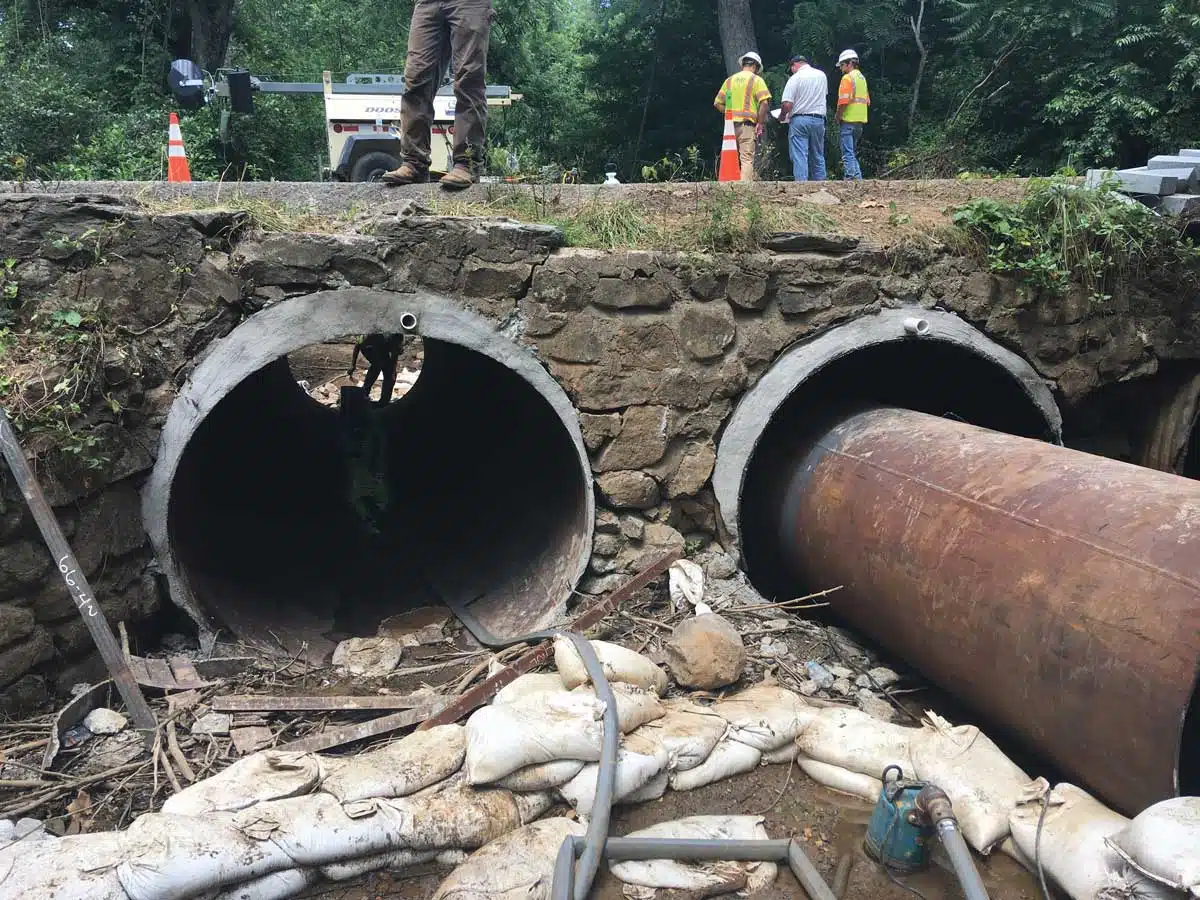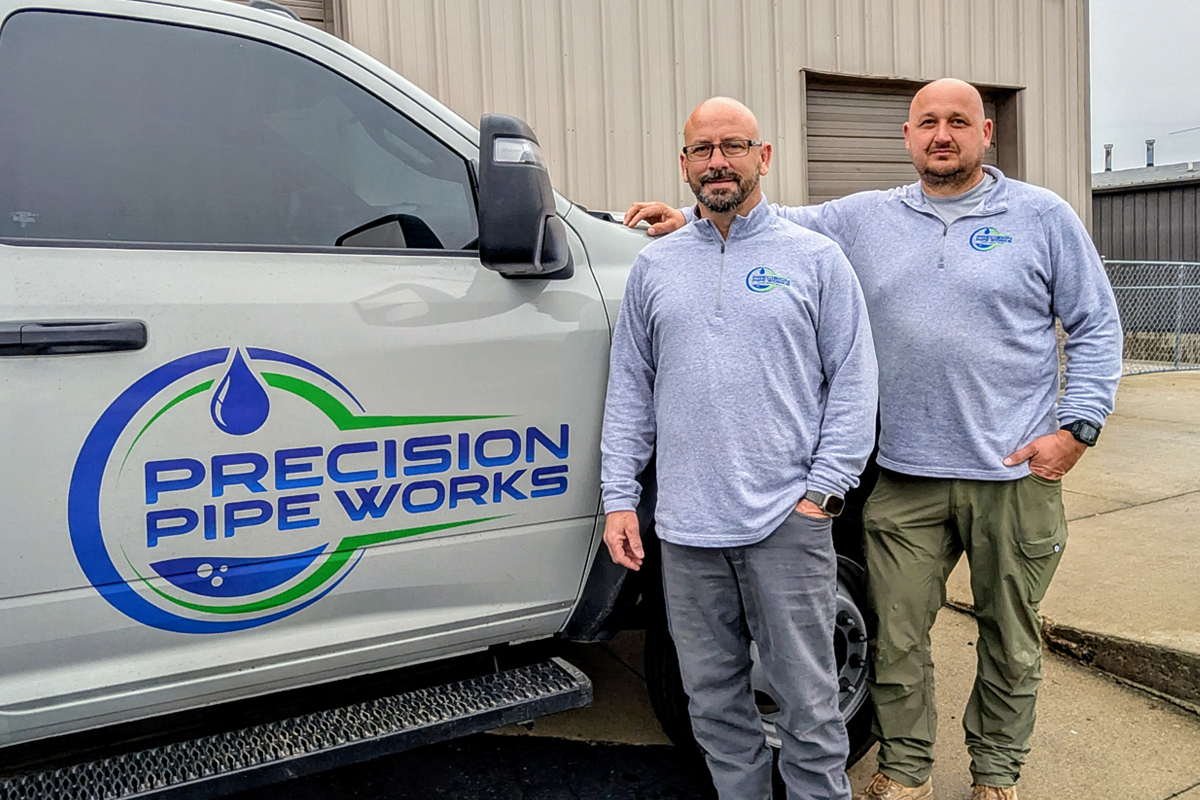
How to Slipline Safely & Successfully
Sliplining is a practical and economical way to rehabilitate failing culverts, and typically requires five essential steps for successful installations.
1. Site Prep
The most important requirement to any sliplining operation is a safe work area. This allows for offloading of the liner sections from trucks and subsequent staging of the liner joints. Work areas should be established at both ends of the existing culvert, with particular attention being paid to the end where the liner sections will be positioned, joined, and slid into place. Arrangements may need to be made with adjacent landowners in order to store the material and access the site. For routine installations, 200 or 300 class excavators are large enough to unload and place the liner sections into position prior to pushing them into the host pipe.
2. Dewatering
Since the function of culverts is to allow water to flow under roadways and railways, water conveyance issues are a typical hurdle that must be dealt with at the project site. If the site has adjacent culvert barrels, the water can easily be diverted through one barrel while the other barrel is being lined. Often, cofferdams positioned upstream are used to hold water while pumps and hoses are used to transfer the water to the adjacent barrel. Bypass pumping system consisting of coffer dams, pumps, and hoses, can also be used to discharge water into other appropriate areas approved by the project owner. These methods are also effective to discharge water through a steel casing pipe that has been jack and bored adjacent to the culvert, thus allowing water to be transferred under the road. On large diameter single barrel culvert projects, water may be pumped through the barrel of the culvert via discharge hoses. In this way, water can be held in upstream dams as additional liner sections are installed.

3. Cleaning
Once the project site is dewatered, the existing culvert needs to be cleaned of debris and sediment, and prepped for lining. Small diameter culverts are often cleaned by jetting water through the barrel or running cleaning tools through them. One creative and cost-effective method, commonly used for small and medium sized culverts, is to run a chain through the culvert barrel and attach it to an old tire. The tire is then pulled back through the culvert; this is amazing to watch if the culvert is full of mud as the mud is immediately expelled. However, for large culverts that are easily accessed the most common way to clean them out is to manually do so with shovels or light equipment.
4. Sliplining
The invert of the liner should be at or slightly lower than that of the existing streambed. If the existing structure is a corrugated metal pipe (CMP) and the invert of the culvert has rusted out or scouring has occurred, the invert may need to be poured with concrete to support the new culvert liner. There may also be torn pieces of CMP that need to be cut out of the structure, as well as any other irregularities that could impede the liner from being positioned into place. Failing concrete culverts may have joint separation and other protruding areas that need to be mitigated prior to lining. In order to mitigate interruptions during the lining process, some liner manufacturers make conical shaped lead sections to help navigate through a host structure that has protrusions. Additionally, laying down a light rail system in the bottom of the existing structure facilitates the installation of the liner by keeping the liner sections aligned, and eases the friction as the liner sections are maneuvered into place.
As the liner sections are positioned for lining the equipment operator should communicate with a designated person in the work area to facilitate aligning the joints and pushing the liner into the host structure. The installation contractor will need to consider that the liner may float during the grouting process. Spacers may be added to the outside of the liner prior to slip lining, to hold the liner on the correct line and grade when the annular space is filled with grout.
Once the liner is loaded inside of the existing structure the ends between the liner and the existing culvert should be sealed to contain the grout as it is pumped inside the annular space. Inserting sandbags between the liner and the host pipe, or using bricks and mortar, are both common methods to seal the ends. These are effective means to contain the grout while it is under pressure during the grouting process.

5. Grouting
A major component of a sliplining project is grouting the annular space between the liner and the existing culvert. The grout not only holds the liner in place over the life of the rehabilitated structure, grouting also provides a degree of structural integrity. The annular space is calculated in order to provide an estimate of the amount of grout that will be required. It is essential to consider that grout should also fill the voids outside of the existing culvert, caused by infiltration of soil through holes in the culvert walls. A 3,000-psi cementitious grout mix, or a flowable fill cellular grout are often used for this purpose. Grout tubes attached to the OD of the liner, which incorporate staggered lengths spaced the length of the liner, are commonly used to allow the grout to be pumped into the annular space. The ends of the grout tubes are exposed and accessible to be attached to grout pump hoses. Another common method is to install grout ports in the walls of the liner, and then attach the pump hoses to the ports from within the liner. The most important thing when grouting the annular space is not to exceed the grouting pressure recommended by the lining manufacturer. Excessive grout pressure can damage the integrity of the liner and cause it to lift off grade within the host pipe. Grouting should also be done in two or three stages to ensure the liner stays in position.
Many of the most effective methods for slipline installation have come through trial and error. This article provides a solid baseline from which future operations can be expanded as technology and installation practices evolve.
Cullom Walker is co-founder of Infrasteel Permanent Culvert Rehabilitation.




